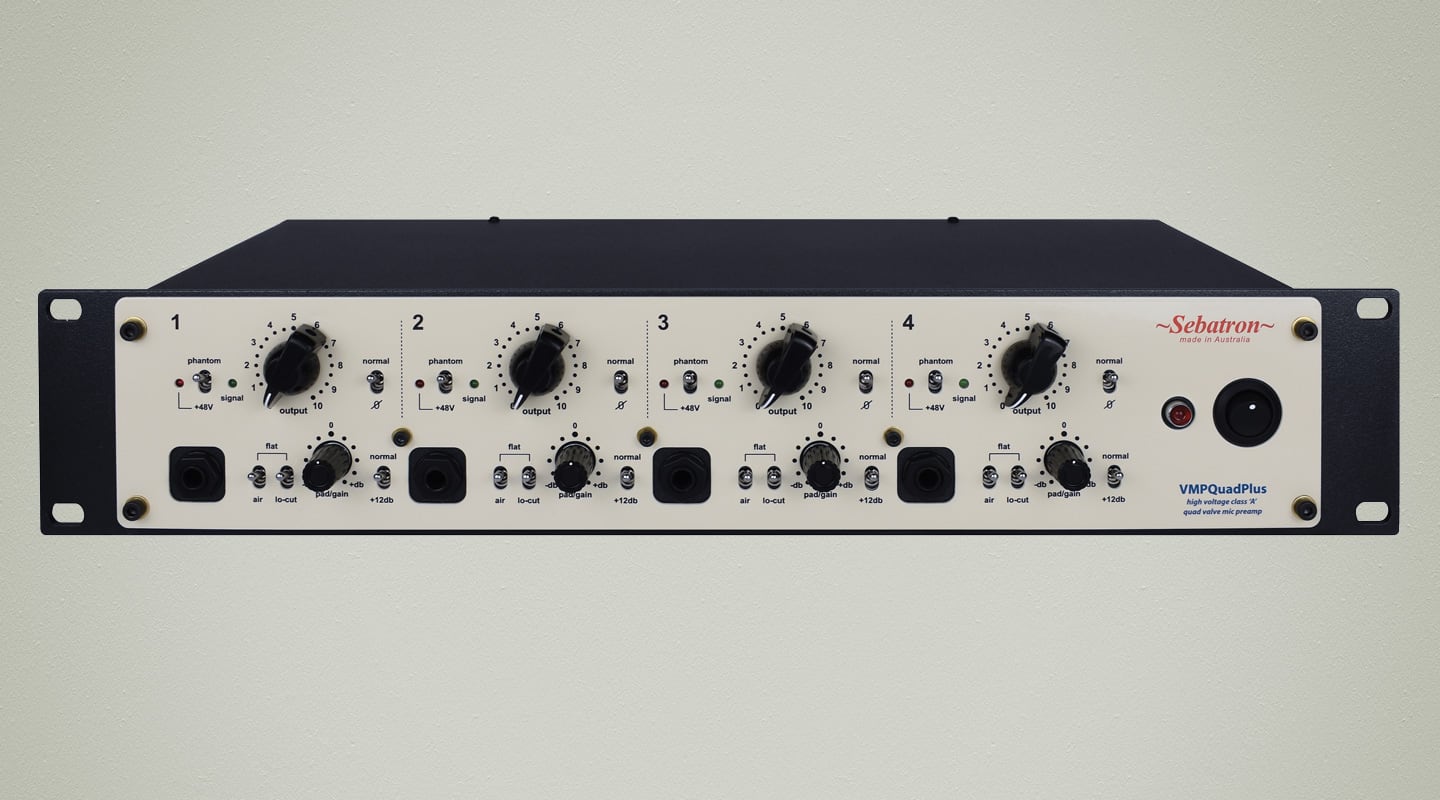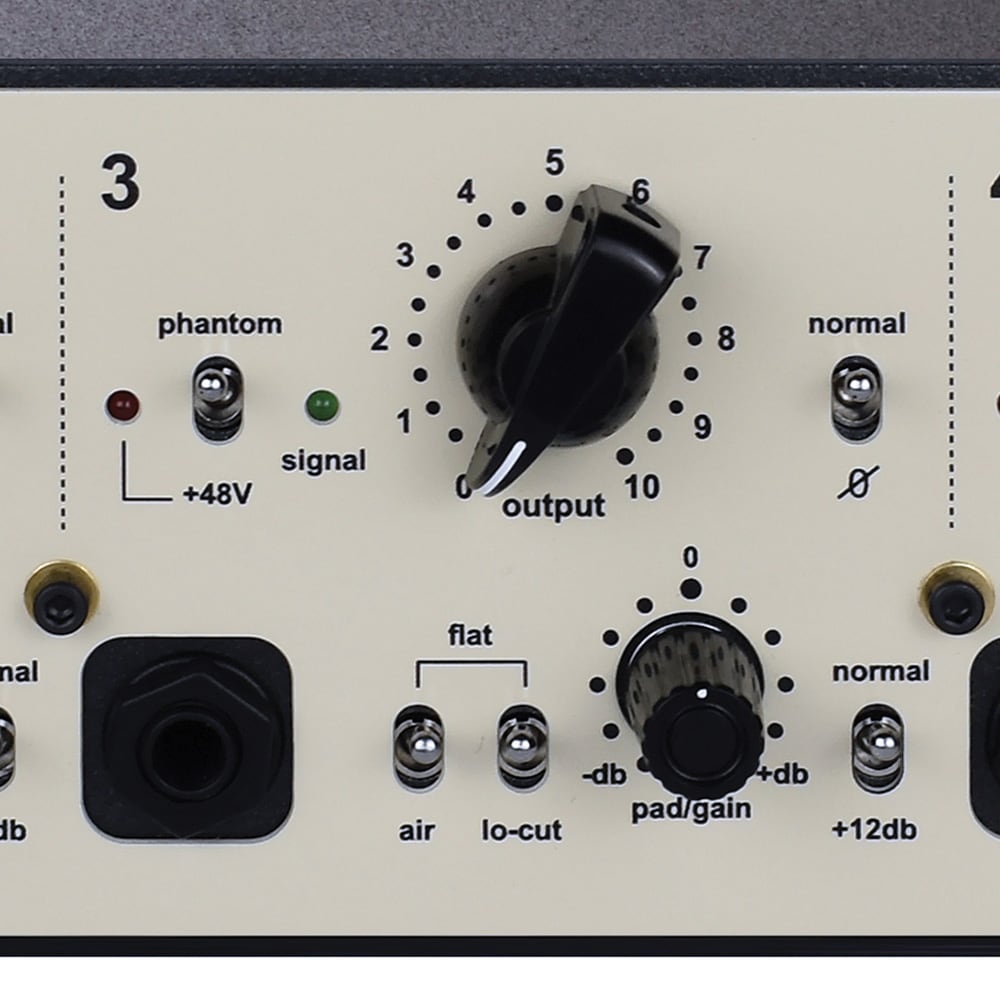
Review: Sebatron VMP Quad Plus
This valve beast is the perfect character to add to your cast of preamps.
If ever there was a preamp to suit the modern recordist, the Australian-made Sebatron VMP Quad Plus could be it. Let’s face it, these days even the IC-based preamps onboard audio interfaces can sound quite good. Everyone with an audio interface has at least two clean, relatively flexible preamps at their fingertips. What they don’t have is character.
Sebatron’s latest four-channel tube microphone preamp ticks a lot of boxes. It’s affordable, built like a tank, and sonically versatile. It can go from crystal clear class A tube gain to coloured with harmonic distortion.
The preamp runs the tube with a proper High Tension voltage, so the tube isn’t starved for power to achieve artificial breakup. Instead, you get all the clean headroom you can get from a 12AT7. While it’s very low noise, this isn’t the ‘absolute’ cleanest preamp — at the clean end of the scale it can induce 0.05% total harmonic distortion, all the way up to 1% when fully driven — but it’s also no fuzz box. Rather, what you get is tonal versatility without ever destroying your sound.
SOLID TUBE LEGACY
The VMP Quad Plus is built upon the legacy of Sebatron’s VMP4000e quad-channel preamp. Sebatron says the majority of the circuit is almost identical. With the new model you get a wider frequency response, a couple more dB of gain, and a ‘lower reaching bottom end’; but they’re all relatively imperceptible, says Sebatron. One isn’t ‘better’ than the other, it’s more about the control interface.
On the VMP4000e, most of the control is switch-based. With those switches you can pad the input to varying degrees, add brightness as well as ‘air’, and a Deep circuit which boosts sub frequencies to go along with the low cut option.
The Bright and Deep circuits are omitted on the VMP Quad Plus, and the switchable pad is replaced with a rotary pad/gain pot. It also adds the ability to toggle between Normal mode — which uses negative feedback to keep the preamp behaviour predictable and clean while sacrificing a little gain — and Open Loop, which is more coloured and adds 12dB of gain.
It means you can really drive the unit by boosting the gain in Open Loop mode, then wind back the output with the main level control. Alternatively, you can keep it clean by keeping the gain at 0dB in Normal mode and adjusting the output to suit.
I haven’t used the VMP4000e; though I’ve seen it in lots of racks. I’m sure its Bright and Deep circuits are very handy for simple tone shaping on the way in, though the Air and low cut on the Quad Plus provide plenty of adjustment. After using the VMP Quad Plus on a range of material, I’m hooked on the flexible harmonic drive characteristics of this version.
NEED TO KNOW
Sebatron VMP Quad Plus
4-Channel Microphone Preamp
OPEN UP THE VALVES
Sebatron use handpicked modern JJ’s valves to keep quality predictable and high. You can, of course, swap the 12AT7s out for a different brand, or dig into some NOS Mullards to vary the tonal signature of the preamps. It’s as easy as popping the hood and wriggling the tube out of its socket. If you want any kind of similarities across your channels though, you’re going to want to buy some matched stock. The 12AT7 has a gain factor of around 60, compared to the 12AX7’s gain factor of 100. Every tube circuit is built around the tube it’s designed for, but a 12AT7 will usually sacrifice gain for a smoother response. It’s still able to add harmonics to the sound when in open loop mode, but it typically won’t crunch and compress like a driven 12AX7. Definitely don’t swap in a 12AX7 for the existing tube.
The unit does get quite warm, so it’s best to give it breathing space. I didn’t notice any adverse effects on the cleanliness of the preamp with it running for full days of tracking. It’s a well-built device, though Sebatron has moved away from a completely screen printed front panel, to a screwed on version. It doesn’t look quite as nice, but I still like the cream look.
As well as the EQ and gain circuitry it’s got all the bits you need in a workhorse preamp; switchable +48V phantom power, phase flip, and a signal indicator LED. There’s no other metering, but it has loads of head room so you won’t overload the input. Anyway, driving the unit is a big part of the charm.
As far as connections go, Sebatron has gone out of its way to make things easy. There are four balanced mic inputs on the rear via XLR, and a 1/4-inch DI input for each channel on the front panel. This goes directly to the plate of the valve, so while you can use either input to process line level signals, Sebatron recommends plugging in via the DI socket.
On the output side, you can come out at line level via the XLR sockets or separate 1/4-inch outputs, which can handle either balanced TRS or unbalanced cables. Very handy if you’re lugging the unit around and don’t have the right cables.

It was a smart move for Sebatron to spinoff a unit dedicated to micro-managing the level of tube flavour imparted on sounds
SPECTRUM OF SOUND
I’ve been eager to get my hands on one of these units for a while. It’s Australian-designed and made, and I’ve only heard good things.
It hasn’t disappointed, the VMP Quad Plus is very clean when operating in Normal mode, with a solid representation of every source. Like any preamp, it’s a matter of suiting the source, but there’s a lot of sources it does suit.
On vocals, the slight bit of compression from adding harmonics helps them both come forward into focus while immediately bedding them into the track. It helped the vocals feel like they belonged.
I did a few recordings where I passively split the output of a Shure SM7 into the VMP Quad Plus and the preamps on a Focusrite Red 8Pre. It’s Focusrite’s flagship interface and no slouch when it comes to the analogue input side. In this mode, the vocal compression was less pronounced than when comparing the recordings made with a condenser. Probably because the less sensitive SM7 does a bit of levelling out itself.
I slapped it up on drums in the classic crush mic position above the kick. It’s a great spot to get a quick balanced mono kit sound. In this instance I was recording a pretty dry drum sound, with a heavily dampened snare in that ’70s close-sound vein. Without the heavy compression I’d usually employ, the Focusrite had slightly more presence to the snare sound, which came across a little cardboard-y in this instance. The Sebatron, on the other hand, contained the snare a bit more while bringing out the woody body of the close sound. It sounded a bit spongier and perfect for the overall drum sound. While just right for that sound, I’d prefer something a tad more snappy for ‘big’ rock drums.
While there are caveats for using the preamps to record a stereo configuration — lack of linearity in open loop mode, and non-repeatable controls — in practise it works fine for non-critical applications. The controls have enough markings around them to get you in the ballpark, and with a critical ear to your centre position, it’s fine. It’s still best to keep it in the normal position to avoid any drift in amplitude and non-linearities; all the things negative feedback keeps under control. I did, however, use it to amplify the signal of a stereo passive ribbon in a Blumlein configuration, and had to use it in Open Loop mode. In that mode I found it harder to keep the mic’s stereo centre pointed at the vocal than it was to line up the two preamp gains. When using the preamps to add character to a line level source you’ll have to line up the two channels with some pink noise. In this case, stepped controls would have been indispensable so you don’t have to constantly recalibrate whenever you make a change to the gain structure.
The variation in colour between the two extremes of clean and full harmonic colouration is relatively dramatic. Recording two passes of an acoustic guitar — one in normal negative feedback mode with gain control set to 0dB and the output control adjusted to match, the other in open loop with the gain all the way up and output control managing the level into my DAW — gave me two quite distinct sounds. The clean tone was everything I usually hear from the guitar, plenty of low end from the dreadnaught shape, but a bit flat overall. The gained up version added a lot more excitement to the mid range of the sound. All in all, it was a much better rendition of the strummed guitar without getting boxy.
The DI input is another very flexible tonal tool. I initially tracked some bass through both the Focusrite and Sebatron and was surprised to hear how similar there reproduced the low end. They both sounded full and tight. After a bit more experimenting with some guitar tracks into some plug-in amp simulation I soon realised the Focusrite sounds slightly saturated, which was a nice touch for an interface DI. The Sebatron could easily match that tone, or drive much harder for a very forward sound, which added some very usable twang and presence. On the other end, in Normal mode, the input was wide-ranging and glassy.
SEBATRON SPINOFF
I really dig what Sebatron is doing. The VMP Quad Plus is not only a great idea, but it’s well executed. Character is everything in music making today, so it was a smart move for Sebatron to spinoff a unit dedicated to micro-managing the level of tube flavour imparted on sounds. All of the things a lot of manufacturers miss, like phase flip, or robust connections, are all the things that makes the VMP Quad Plus even easier to recommend. Whether you don’t have any outboard preamps or have an entire rack of them, there’s a spot in there for the sort of versatile tube character the VMP Quad Plus can impart.



























RESPONSES